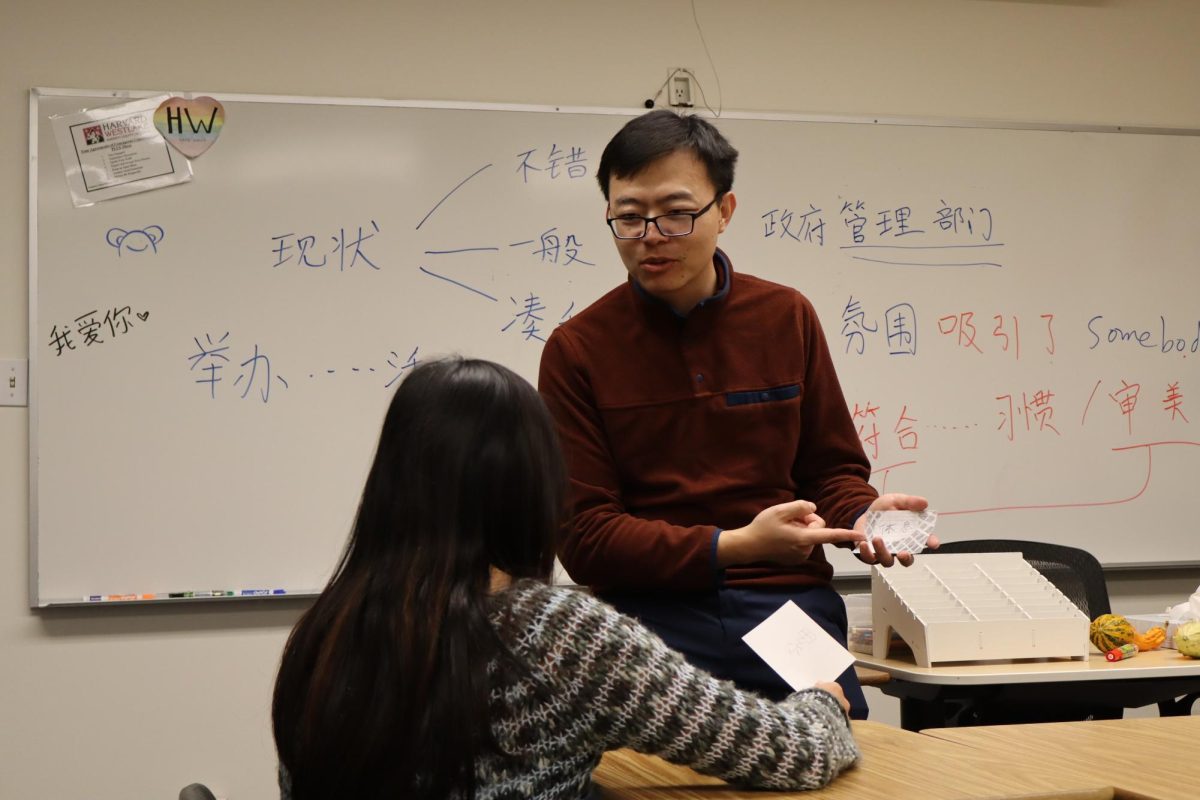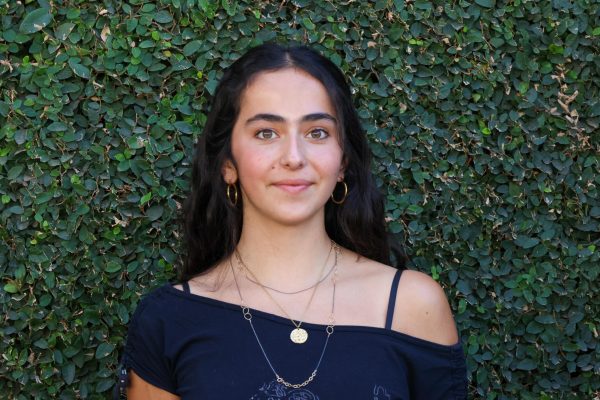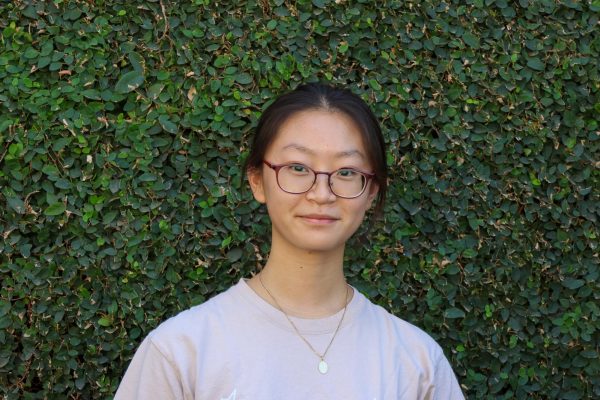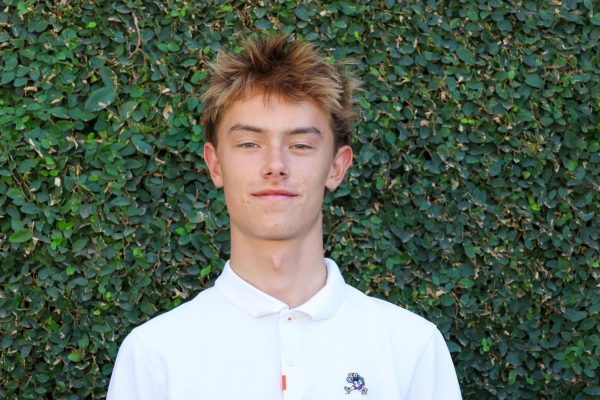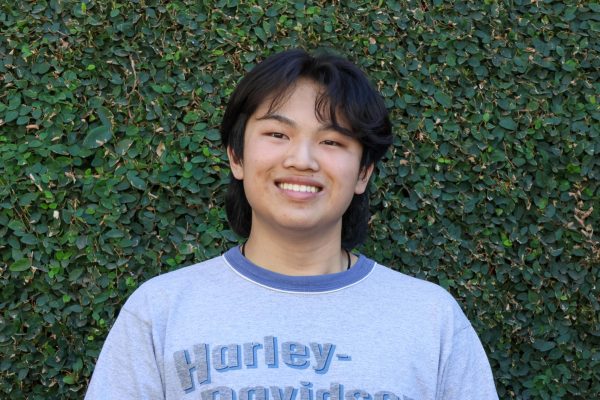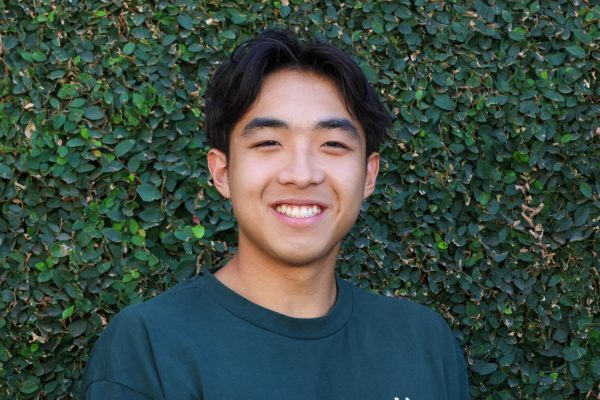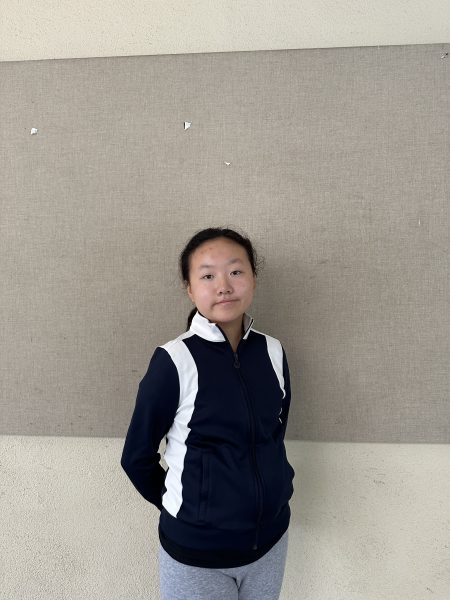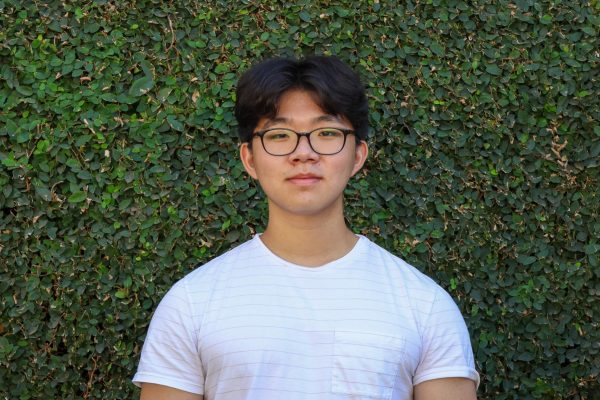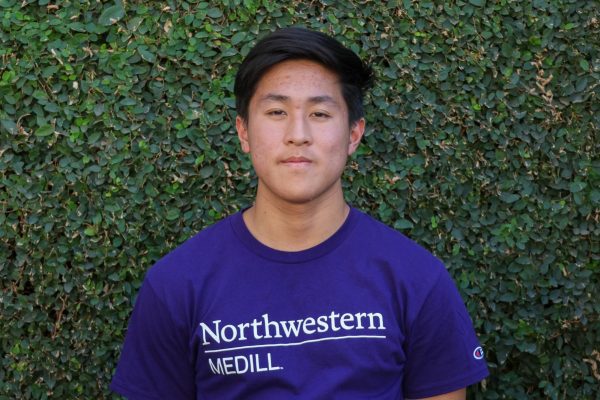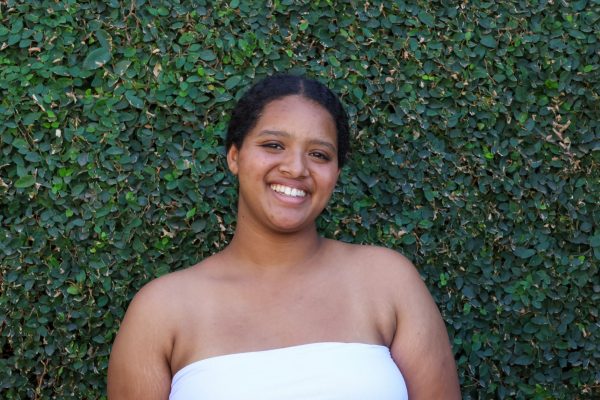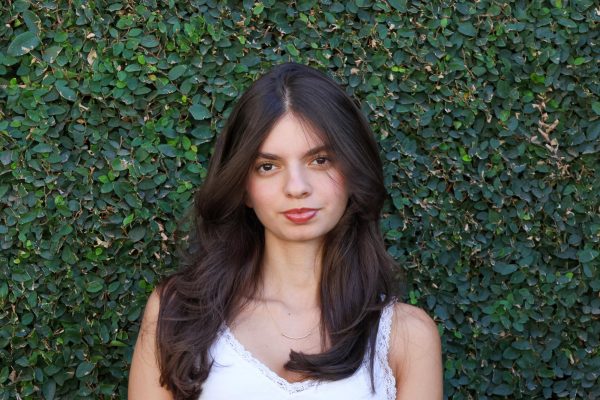Chloe Dolkart
By Sienna Dall’Olmo
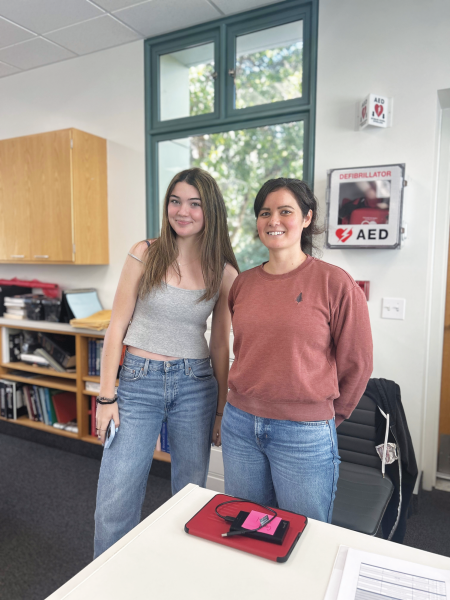
Chloe Dolkart ’24 is studying the relationship between COVID-19 and developing Type 1 diabetes for her Senior Independent Study. Dolkart is working with Upper School Science Teacher Dr. Chelsea Stewart to find and analyze ideas for her research paper.
Dolkart said she chose her topic because of her personal knowledge and intrigue in COVID-19’s effect on young people.
“I was inspired to choose this topic because of personal experience and interest in COVID-19’s effects on the youth population,” Dolkart said. “I am excited to learn more about the specific traits of both Type 1 diabetes and COVID-19 as well as the heritability of Type 1 diabetes.”
Stewart said she accepted the role of advisor because she found Dolkart’s observation interesting.
“I agreed to advise the independent study because I thought Chloe’s question was very intriguing,” Stewart said. “Additionally, as a teacher, I love to watch a student’s curiosity lead them to new questions and new discoveries.”
Dolkart said the biggest challenge in her research so far has been incorporating the new and dynamic information on COVID-19.
“I think the biggest struggle in my research is synthesizing all the information and finding current studies since COVID-19 research is continuously evolving and it is important to stay up to date on the information,” Dolkart said. “Working with Dr. Stewart has given me another perspective on finding important points to put in my paper as well as someone to run ideas by who already has tons of knowledge on what I am studying.”
Elizabeth Johnstone
By Erin Ryu

Elizabeth Johnstone ’24 is studying environmental concerns and changes in water pollution policy in Vietnam-era U.S. for her Senior Independent Study.
Johnstone said she chose her topic because it matched her academic and personal interests.
“I love history, environmental science, public policy and writing, so it was awesome to be able to apply for a project like this,” Johnstone said. “More specifically, Vietnam-era America is one of my favorite periods to learn about. It was such a dynamic time, and we’re seeing very similar impetus for social and political change today.”
Johnstone said she had to adjust her initial study to expand upon administrative responses based on her findings of public feedback.
“Originally, I set out to study how the creation of the EPA [Environmental Protection Agency] may have led to more robust state and regional water pollution policy, but after the first quarter of research, I‘ve had to pivot a little to fit the literature I’ve been finding,” Johnstone said. “I’m still investigating water pollution policy, but now I’m shifting to see how specific public opinion, outcry and policy at the state level influenced federal response.”
Johnstone said she plans on incorporating past and present policies in her final 30-page research paper.
“I’ll be synthesizing what I find about the ’60s and ’70s with research about today’s water policy landscape, hopefully drawing some insightful conclusions about what policymakers can learn from what happened half a century ago,” Johnstone said.
Johnstone said she chose Upper School History Teacher Celia Goedde as her advisor because of her expertise in the historical field.
“I’ve had Dr. Goedde for all three years at the Upper School, and I have to say that she’s only helped my love for history, analysis and research blossom,” Johnstone said. “Dr. Goedde has such an incredible wealth of knowledge, so I’m very thankful to be able to work with her even more this semester.”
Goedde said she is looking forward to Johnstone’s final project and her discoveries .
“Just as I expected, [Johnstone] is making strong progress with her research and shaping the focus of her analysis,” Goedde said. “She is taking a very ambitious approach by comparing the actions of both federal and state governments in two different time periods. That requires a great deal of research and focus but promises to yield some very interesting points of comparison. I am looking forward to seeing her comparisons of environmental policies from such different eras.”
Dillon Ring
By Everett Lakey
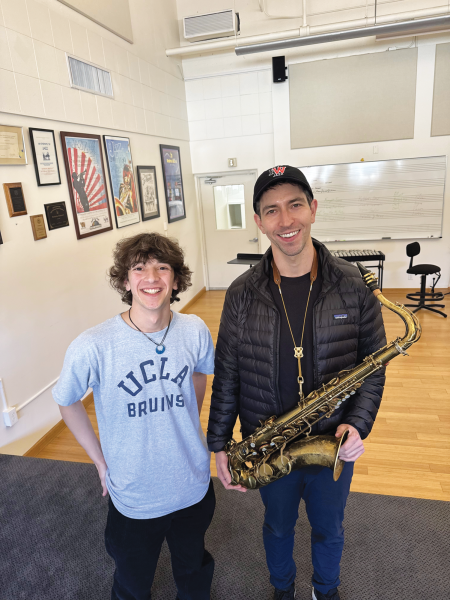
Dillon Ring ’24 is composing, playing and recording an original jazz album for his Senior Independent Study. Ring will play all instruments for the pieces, including the saxophone, bass, drums and piano . The album will feature some of Ring’s friends who have impacted his musical career.
Ring said the album will also include homages to his inspirations as a musician.
“All the songs are based on motifs from musical influences ,” Ring said. “One song is called ‘To Live,’ and it’s based on Sonny Rollins. [He] is well known for trio playing, which [includes] no chords. It’s usually bass, drums and saxophone. For that song specifically, I will also play in a trio setting, and I will try and emulate some things about his playing.”
Upper School Jazz Teacher Chris Sullivan is serving as Ring’s faculty advisor. Sullivan said said his main role is to help Ring edit and refine his compositions.
” I have been able to help with small melodic tweaks here and there that have come from spending the past 18 years working to understand the jazz language and its different dialects,” Sullivan said. “Swing, bebop, hard bop, cool jazz, etc., all have their own language, and we’ve worked to make the compositions as true to the different styles as possible.”
Ring said he has loved working with Sullivan since he was appointed the Jazz band director.
“[Sullivan] is amazing. He’s my favorite teacher,” Ring said. “He’s been our band director for three years, and it’s been the most amazing experience. I chose him [as my advisor] because he is a seasoned expert in jazz. He’s a professional musician himself, [and] he knows everything there is to know about composition, jazz and how someone would go about doing a project like this. It was perfect because he’s been great at guiding the entire program throughout his time here.”
Aidan Deshong
By Colin Ho

Aidan Deshong ’24 is writing a textbook about logic puzzles and how they connect to larger mathematical concepts for his Senior Independent Study.
Deshong said the textbook aims to teach readers how to become better at solving logic puzzles and understand the mathematics behind them.
“The textbook is a mix of handcrafted puzzles, drills or practice problems to help the reader discover solving techniques on their own and [includes] writing about how the puzzles connect to mathematics at large,” Deshong said. “It has all of the classics like Sudoku, as well as [other puzzles] that I hadn’t even heard of before starting the project. [Many] of [the puzzles] feature connections to topics like graph theory or combinatorics.”
Deshong said learning how to create and format puzzles has been a learning curve for him.
“It’s a lot more time-consuming to create puzzles than I thought it would be,” Deshong said. “The upside is that I’ve found a good mix of knowing what I want a puzzle to accomplish and seeing what kinds of puzzles a computer generates, which makes the whole thing quicker. It can also be pretty time-consuming to format all of the puzzle diagrams, but fortunately other people have found ways to input all of the diagrams.”
Mathematics Teacher Laffite Lamberto-Egan is serving as Deshong’s faculty adviser. Lamberto-Egan said he quickly took interest in Deshong’s Senior Independent Study due to his personal love for logic puzzles.
“[Like Deshong], [I] enjoy playing games and solving puzzles,” Lamberto-Egan said. “It’s doubly enjoyable for me when I encounter puzzles which have a mathematical connection. [Deshong’s] project immediately caught my eye.”
Lamberto-Egan said advising Deshong has been an enjoyable process.
“It’s been pretty fun so far,” Lamberto-Egan said. “Mainly, I just read the chapters that [Deshong] has written, listen to him describe where he is headed and make sure he is meeting his deadlines so he finishes the project in time.”
Lamberto-Egan said he chose to advise Deshong because he thought Deshong was an outstanding student with a passion for learning.
“I chose to advise [Deshong] because I taught him last year in Multivariable Calculus and he stood out as a highly motivated student with a very inquisitive mind,” Lamberto-Egan said. “I knew that whichever topic he chose to research in his independent study would be very interesting, and I was excited to learn [with] him.”
Chris Robertson
By Nathan Wang
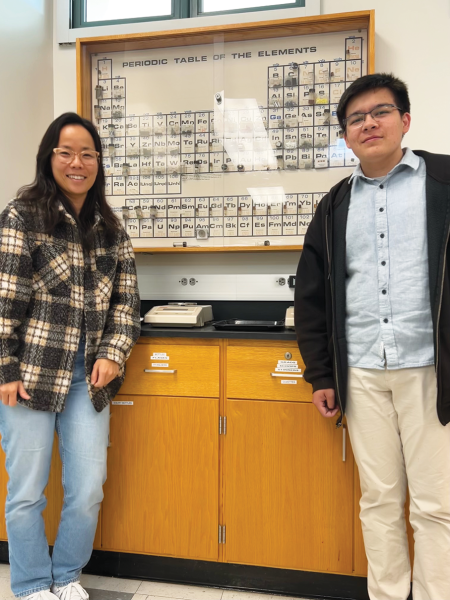
Chris Robertson ’24 is coding a program that predicts the molecular structure of an unknown molecule using quantum chemistry for his Senior Independent Study. By using the Hartree–Fock method in his code, Robertson will theoretically map the organization of electrons that yields the lowest total molecular energy. Robertson’s code moves the nuclei of atoms in a molecule to experiment with the molecule’s energy and predict the geometry of the unknown molecule.
Robertson said while his project’s code is difficult, being able to understand the applicable theoretical aspects of quantum chemistry is even more challenging.
“The hard part isn’t the coding,” Robertson said. “The hard part is wrapping my head around the topic. The coding isn’t easy, but it’s secondary to figuring out what all of [the quantum mechanical theory] means.”
Robertson said the most rewarding part of his project is being able to expand on his knowledge to create an accurate program.
“When I first read articles about [my topic] , I had no idea what any of [the information] meant,” Robertson said. “But after spending hours and hours doing more reading, opening a new tab, looking up this random term and going through a textbook, it was really gratifying to [understand] what [the research is] talking about. I understand stuff that I never would have understood a month ago. It was satisfying to see the program output something, even if it wasn’t the most accurate.”
Science Teacher Narae Park is serving as Robertson’s faculty advisor and previously taught him in Advanced Placement (AP) Chemistry. Park said advising such a complex project is a learning experience for herself.
“I know chemistry, but I know nothing about computer science,” Park said. “What [Robertson] is doing is very interesting because his idea is so foreign to me. I feel like [Robertson] is helping me more than I’m helping him, but it’s a good experience.”
Maddie Baffo
By Audrey Kim

Madison Baffo ’24 is studying mental health for Black teens for her Senior Independent Study project, and how to better support for Black students in the school and throughout America.
Baffo said she reflected on how her personal identity and stigma against it impacted her mental health, during the coronavirus lockdown, and started to think about the wide variety of causes of her struggles.
“I began to break down several factions of my life and their intersections.” Baffo said. “I learned that as a Black female student in a rigorous, predominantly white institution, I was navigating a beyond complex and distinct experience that would not apply to many HW students in hegemonic groups. Apart from this, I also explored the Black community’s generational stigma towards mental health and how it can sometimes create an unwelcoming environment to be vulnerable.”
Baffo said her independent study aims to find better ways to teach mental health topics and help Black teens with their struggles through chronicling student thoughts and experiences in a film.
“I’m going to create a documentary capturing the participants’ thoughts, experiences and background with mental health and their journey using the reflection, coping mechanisms and exercises I will share and teach,” Baffo said. “My underlying goal is to create lasting digital content that can be a source of representative reference for Black kids everywhere. I hope they will use these creative works to benefit their lives where these conversations may be unsafe.”
Baffo said her faculty advisor, Upper School Counselor Brittany Bronson, has been a great help to her.
“I reached out to Bronson because she is a prominent therapist and counselor at the school, and she is also Black, so she may have personal experience as well.” Baffo said. “Bronson and I came up with the curriculum together, what topics we wanted to cover and what activities we wanted to do, so she helped me greatly with that.”
Oren Hartstein
By Alex Lee
Oren Hartstein ’24 is studying how to integrate a nontraditional method of physics known as Lagrangian Physics into the school’s advanced physics curriculum for his Senior Independent Study .
Hartstein said Newtonian physics is effective for simpler physics problems, but application is difficult as problems become more complex.
“Students learn about Newtonian mechanics as their first introduction to physics,” Hartstein said. “This is all well and nice when you’re dealing with simple objects and forces, but when you get to anything a little bit more complex, Newtonian mechanics become unruly. You need a new approach, [and] that new approach is Lagrangian mechanics.”
Hartstein said the main motive behind his Senior Independent Study is the lack of an advanced physics curriculum at the school. Hartstein said he looks forward to learning more about the subject through his research.
“I had a great time in [Advanced Placement] Mechanics and [Electricity and Magnetism] ,” Hartstein said. “But unfortunately, there’s nothing offered as a class at [the school] that allows me to learn more physics. So I thought, ‘How can I learn some of this information by myself?’ Lagrangian mechanics seemed like a natural starting point, and I’m excited to see where it will take me.”
Hartstein said while restructuring the entire physics curriculum is unrealistic, he hopes to find a place for Lagrangian mechanicsin more advanced physics courses.
“[Lagrangian mechanics]is too difficult to teach in an introductory class,” Hartstein said. “But my hope is that I will be able to find ways of distilling some of these ideas, like using minimization principles to explain how things work.”
Upper School Science Teacher Jesse Reiner said he agreed to serve as Hartstein’s faculty advisor given his pleasant experiences teaching him physics last year.
Working with [Hartstein] last year was great, both from a teaching standpoint and a learning standpoint,” Reiner said. “Continuing to work with [Hartstein] felt like an opportunity to help him learn more physics and to learn a bit more myself.”
Reiner said advising Hartstein has challenged him to learn new material for the project.
“ [Hartstein] is learning an approach to physics that I have never studied, and it involves some math called ‘the calculus of variations’ with which I’m only slightly familiar,” Reiner said. “Perhaps other physics or math teachers will be able to step in and help if we get stuck.”
Wyatt Lake
By Max Turetzky
Wyatt Lake ’24 is studying graph theory, which uses complex mathematical structures to model relationships within a network, for his Senior Independent Study.
Lake said his project will involve launching an educational website that introduces users to graph theory.
“The point of the [Senior] Independent Study is to learn graph theory from a math textbook and then create an online interactive tool to teach graph theory,” Lake said. “We’re currently planning three to four lectures, and the interactive lessons will allow users to view different proofs or lessons about graphs. [Graph theory] comes up in a lot of fields, [such] as computer science and chemistry .”
Upper School Math Teacher Kevin Weis is serving as Lake’s faculty advisor. Weis said he appreciates the challenges and rewards of studying graph theory with Lake.
“[Lake] comes in to meet with me once a cycle,” Weis said. “He reads a chapter from the book, and he explains the concepts that he learned. Then, the two of us sit for about an hour and a half and try to prove things. These are problems from the textbook, but at this level of math, they’re all about proving facts on the concept you learned. Sometimes we fail and can’t figure it out, and other times we figure it out, and it’s the highlight of my week.”
Lake said he became interested in graph theory because it was relatively simple to understand and teach compared to other types of advanced math.
“I talked with Mr. Weis about potential branches of math that we could do,” Lake said. “There are a couple interesting things about graph theory. One is that it’s very visual, so it lends [itself] to building lessons. The other is that graph theory doesn’t require too much background. There are a lot of other branches of math like number theory or category theory which require years of undergraduate and graduate classes to fully understand. Graph theory is a newer branch of math, so there’s a lower barrier to entry.”
Ellery Shapiro
By Justin Tang
Ellery Shapiro ’24 is studying abnormal psychology and the representation of mental illness in the media for her Senior Independent Study. Shapiro is analyzing the impact of the media on mental health stigma, as well as the accuracy of media representations compared to the Diagnostic and Statistical Manual of Mental Disorders (DSM).
Shapiro said she decided to do an independent study to further her knowledge of psychology.
“Last year I took the Science of Psychology class with [Interdisciplinary Studies and Independent Research Teacher Tina McGraw] and absolutely loved it, but unfortunately [the school] doesn’t offer any psychology courses beyond this class,” Shapiro said. “In order to continue studying psychology, I applied for an independent study and got to design this course.”
Shapiro said she is specifically focused on the causes that perpetuate false media representations.
“I am on the verge of submitting my first research paper, in which I attempt to explain the origins of the pervasive negative depictions of mental illness and mental health treatment in film, as well as the economic and psycho-biological mechanisms that sustain them,” Shapiro said.
McGraw, who is Shapiro’s faculty advisor, said media representations of mental health often pique the interest of consumers.
“For this first paper, what [Shapiro] is finding is that [the media portrays] people with mental health struggles as unstable and violent, which is coming across in a lot of the novels that she’s reading,” McGraw said, “We’re developing a little bit more of a theory around why we’re so drawn to these kinds of stories as readers, and what it is about reading about people with these experiences of being locked up in asylums that grab our attention? What part of our own psyche do they disturb and captivate?”
Claire Wu
By Lydia Gugsa
Claire Wu ’24 is studying social media usage and misinformation intervention strategies in China and the U.S. for her Senior Independent Study.
Wu said her project was inspired by a photograph she saw that highlighted the differences between Chinese and American media.
“When I was researching for a project, I found the picture of the ‘Tank Man’ from the Tiananmen protests in Beijing, China,” Wu said. “I had not seen this picture [in] Chinese media or online resources. Chinese media and American media have different systems and policies, but there are also similarities. I wanted to study why the media is like what it is now, and how the public might be affected by it.”
Wu’s project culminates in a 13-18 page research paper analyzing media policies and laws in both countries. The paper will also discuss how information is being released in the U.S. versus China .
Upper School History Teacher Conrad Cuda is serving as Wu’s faculty advisor. After taking his U.S. History class last year, Wu was motivated to dive deeper into the topic of social media usage. .
“Mr. Cuda’s class inspired me to pick this topic ,” Wu said. ” Mr. Cuda [also] has a profound knowledge of American media’s current situation.”
Cuda said he looks forward to working with Wu to explore the impact of social media usage in different countries.
“I [had] the privilege of working with [Wu] last year in U.S. History, so I’m looking forward to getting to work with her [again],” Cuda said. “We are both interested in how technology, specifically social media, impacts people’s information and media literacy.”
Cuda said Wu’s previous life experiences in China give her unique perspectives and insights.
“[Wu] spent a larger portion of her life growing up outside of the United States, which was an invaluable asset to our class last year,” Cuda said. “She was always able to shed light on perspectives that did not come naturally to everyone in the class who hadn’t had the experience of living outside of the United States.”
Grace Adams
By Eila Shokravi
Grace Adams ’24 is studying the importance of architectural preservation for historic architecture in Los Angeles for her Senior Independent Study. She decided to focus on the work of Paul Williams, an architect based in Los Angeles.
Adams was inspired to explore this topic because she has interned over the past year with a landscape architect.
“He has taught me a lot about restoration though showing me projects he has done and is doing, as his firm has participated in historical preservation projects and adaptive reuse on notable mid-century projects,” Adams said.
Adams’s faculty adviser, Art History Teacher Katherine Holmes-Chuba, said her favorite part about working with Adams is her passion for this project.
“[I love Adams’s] sheer enthusiasm for the project, she’s totally into it,” Holmes-Chuba said. “Every discussion is really fun.”
Holmes-Chuba said she had learned a lot through studying architecture within Los Angeles with Adams.
“Architecture is not my specialty, but I love architecture so this has been a great learning opportunity for me too,” Holmes-Chuba said. “We go meander through architects and architectural philosophies in Los Angeles and the history of Los Angeles.”
Adams said she hopes hopes that presenting this experience, of studying architecture within Los Angeles, to her peers will allow her to work on her presenting skills which she will use when she grows older and works at an architectural firm.
“I hope to get good experience with presenting my ideas in front of a group of people,” Adams said. “This will be something I have to do on a regular basis when I am older at an architecture firm.”



























